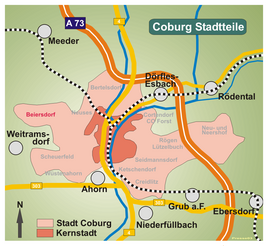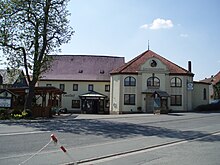Beiersdorf near Coburg
|
Beiersdorf (with Callenberg)
independent city of Coburg
Coordinates: 50 ° 17 ′ 9 ″ N , 10 ° 55 ′ 33 ″ E
|
|
|---|---|
| Height : | 310 m above sea level NN |
| Area : | 7.31 km² |
| Residents : | 1476 (Jun 30, 2010) |
| Population density : | 202 inhabitants / km² |
| Incorporation : | July 1, 1972 |
| Postal code : | 96450 |
| Area code : | 09561 |
|
Location of Beiersdorf (with Callenberg) in Coburg
|
|
Beiersdorf is a north-western district of the Upper Franconian city of Coburg , which was called Beiersdorf b.Coburg before it was incorporated in 1972 .
geography
The village borders on the Coburg core city, the Coburg districts Bertelsdorf and Neuses and the communities of Meeder and Weitramsdorf .
On June 30, 2010 Beiersdorf had 1,476 inhabitants, which results in a population density of 202 inhabitants per km². The village is on State Road 2205 , which leads from Coburg to Bad Rodach .
In the center of the village is the “Zum Schwarzen Bären” inn. The core of the building dates from the 17th century and has a dance hall from 1910. The Hanft brewery was affiliated between 1876 and 1945.
history
The first written mention of Beierdorf is dated to 1231 with the name Beersdorf . In 1317 the name Beiersdorf was mentioned for the first time, which probably comes from a personal name Beier.
At the end of the 18th century, the place had 34 houses that stretched along Rodacher Strasse and 156 inhabitants. In 1910 there were 336 and in 1939 461 inhabitants. On April 1, 1928, Callenberg was incorporated. When it was incorporated into Coburg on July 1, 1972, 919 people lived in Beiersdorf, which covered a community area of 713 hectares. The community consisted of the three places Beiersdorf, Callenberg and Kropfweihers. The wasteland of Kropfweiher, located in the Callenberger Forest, was abandoned and leveled in 1975. ⊙
After the opening of the Coburg – Bad Rodach railway in 1892, Beiersdorf had a stop that was closed at the end of the 20th century. A brewery existed from 1876 to 1945. It was founded by E. Schuffner and taken over in 1878 by the Hanft family, who still own the Zum Schwarzen Bären inn today .
In 1988 a Waldorf school was opened in Beiersdorf . The school uses buildings from the former Callenberger Farm, which was built as a model ducal farm in 1863. Beiersdorf has the character of a village settlement. Three new development areas have been built since the 1990s.
On April 30, 2013 TSV Beiersdorf celebrated its 100th anniversary in the hall of the Gasthof zum Schwarzen Bären.
Attractions
- The area of Beiersdorf includes the Callenberger Flur with the Callenberg Castle , which was first mentioned in 1122, and the associated Castle Park, an English landscape garden.
- List of architectural monuments
literature
- Peter Morsbach, Otto Titz: City of Coburg. Ensembles-Architectural Monuments-Archaeological Monuments . Monuments in Bavaria. Volume IV.48. Karl M. Lipp Verlag, Munich 2006, ISBN 3-87490-590-X , pp. 419-421.
Web links
Individual evidence
- ^ Wilhelm Volkert (ed.): Handbook of Bavarian offices, communities and courts 1799–1980 . CH Beck, Munich 1983, ISBN 3-406-09669-7 , p. 441 .
- ↑ Harald Sandner: Coburg in the 20th century. The chronicle of the city of Coburg and the House of Saxe-Coburg and Gotha from January 1, 1900 to December 31, 1999 - from the "good old days" to the dawn of the 21st century. Against forgetting. Verlagsanstalt Neue Presse, Coburg 2002, ISBN 3-00-006732-9 , p. 272


